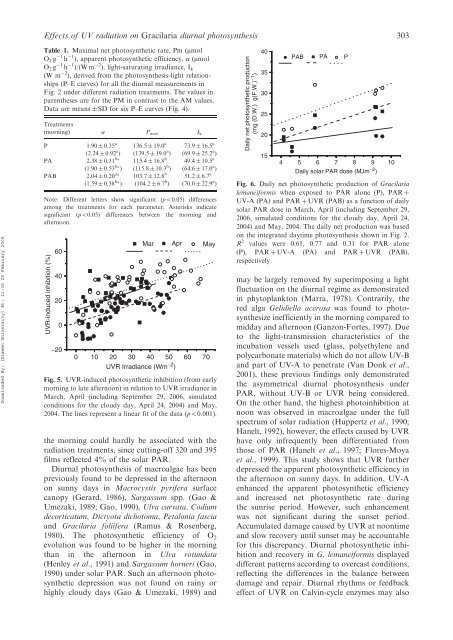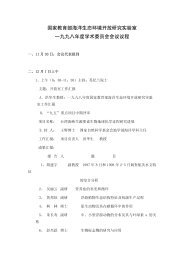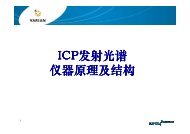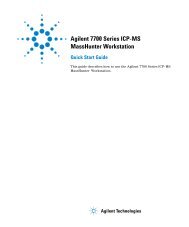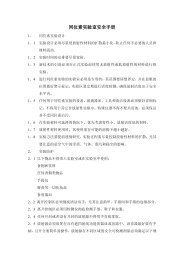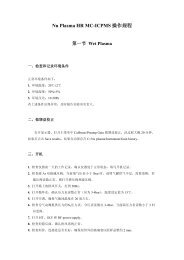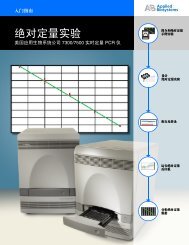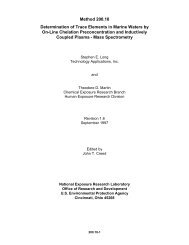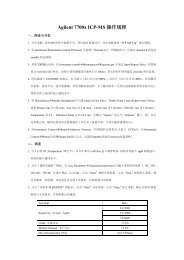Effects of solar UV radiation on diurnal photosynthetic performance ...
Effects of solar UV radiation on diurnal photosynthetic performance ...
Effects of solar UV radiation on diurnal photosynthetic performance ...
You also want an ePaper? Increase the reach of your titles
YUMPU automatically turns print PDFs into web optimized ePapers that Google loves.
<str<strong>on</strong>g>Effects</str<strong>on</strong>g> <str<strong>on</strong>g>of</str<strong>on</strong>g> <str<strong>on</strong>g>UV</str<strong>on</strong>g> <str<strong>on</strong>g>radiati<strong>on</strong></str<strong>on</strong>g> <strong>on</strong> Gracilaria <strong>diurnal</strong> photosynthesis 303<br />
Downloaded By: [Xiamen University] At: 11:35 26 February 2009<br />
Table 1. Maximal net <strong>photosynthetic</strong> rate, Pm (mmol<br />
O 2 g 1 h 1 ), apparent <strong>photosynthetic</strong> efficiency, (mmol<br />
O 2 g 1 h 1 )/(W m 2 ), light-saturating irradiance, I k<br />
(W m 2 ), derived from the photosynthesis-light relati<strong>on</strong>ships<br />
(P–E curves) for all the <strong>diurnal</strong> measurements in<br />
Fig. 2 under different <str<strong>on</strong>g>radiati<strong>on</strong></str<strong>on</strong>g> treatments. The values in<br />
parentheses are for the PM in c<strong>on</strong>trast to the AM values.<br />
Data are means SD for six P–E curves (Fig. 4).<br />
Treatments<br />
(morning) P max I k<br />
P 1.90 0.35 a 136.5 19.0 a 73.9 16.5 a<br />
(2.24 0.92 a ) (139.5 19.0 a ) (69.9 25.2 a )<br />
PA 2.38 0.31 b 115.4 16.8 b 49.4 10.5 a<br />
(1.90 0.53 b ) (115.8 10.3 b ) (64.6 17.0 a )<br />
PAB 2.04 0.20 a 103.7 12.8 b 51.2 6.7 a<br />
(1.59 0.38 b ) (104.2 6.7 b ) (70.0 22.9 a )<br />
Note: Different letters show significant (p50.05) differences<br />
am<strong>on</strong>g the treatments for each parameter. Asterisks indicate<br />
significant (p50.05) differences between the morning and<br />
afterno<strong>on</strong>.<br />
<str<strong>on</strong>g>UV</str<strong>on</strong>g>R-induced inhibiti<strong>on</strong> (%)<br />
60<br />
40<br />
20<br />
0<br />
−20<br />
Mar<br />
Apr<br />
0 10 20 30 40 50 60 70<br />
<str<strong>on</strong>g>UV</str<strong>on</strong>g>R Irradiance (Wm −2 )<br />
May<br />
Fig. 5. <str<strong>on</strong>g>UV</str<strong>on</strong>g>R-induced <strong>photosynthetic</strong> inhibiti<strong>on</strong> (from early<br />
morning to late afterno<strong>on</strong>) in relati<strong>on</strong> to <str<strong>on</strong>g>UV</str<strong>on</strong>g>R irradiance in<br />
March, April (including September 29, 2006, simulated<br />
c<strong>on</strong>diti<strong>on</strong>s for the cloudy day, April 24, 2004) and May,<br />
2004. The lines represent a linear fit <str<strong>on</strong>g>of</str<strong>on</strong>g> the data (p50.001).<br />
the morning could hardly be associated with the<br />
<str<strong>on</strong>g>radiati<strong>on</strong></str<strong>on</strong>g> treatments, since cutting-<str<strong>on</strong>g>of</str<strong>on</strong>g>f 320 and 395<br />
films reflected 4% <str<strong>on</strong>g>of</str<strong>on</strong>g> the <str<strong>on</strong>g>solar</str<strong>on</strong>g> PAR.<br />
Diurnal photosynthesis <str<strong>on</strong>g>of</str<strong>on</strong>g> macroalgae has been<br />
previously found to be depressed in the afterno<strong>on</strong><br />
<strong>on</strong> sunny days in Macrocystis pyrifera surface<br />
canopy (Gerard, 1986), Sargassum spp. (Gao &<br />
Umezaki, 1989; Gao, 1990), Ulva curvata, Codium<br />
decorticatum, Dictyota dichotoma, Petal<strong>on</strong>ia fascia<br />
and Gracilaria foliifera (Ramus & Rosenberg,<br />
1980). The <strong>photosynthetic</strong> efficiency <str<strong>on</strong>g>of</str<strong>on</strong>g> O 2<br />
evoluti<strong>on</strong> was found to be higher in the morning<br />
than in the afterno<strong>on</strong> in Ulva rotundata<br />
(Henley et al., 1991) and Sargassum horneri (Gao,<br />
1990) under <str<strong>on</strong>g>solar</str<strong>on</strong>g> PAR. Such an afterno<strong>on</strong> <strong>photosynthetic</strong><br />
depressi<strong>on</strong> was not found <strong>on</strong> rainy or<br />
highly cloudy days (Gao & Umezaki, 1989) and<br />
Daily net <strong>photosynthetic</strong> producti<strong>on</strong><br />
(mg (D.W.) g(F.W.) −1 )<br />
40<br />
35<br />
30<br />
25<br />
20<br />
15<br />
PAB<br />
PA<br />
4 5 6 7 8 9 10<br />
Daily <str<strong>on</strong>g>solar</str<strong>on</strong>g> PAR dose (MJm −2 )<br />
Fig. 6. Daily net <strong>photosynthetic</strong> producti<strong>on</strong> <str<strong>on</strong>g>of</str<strong>on</strong>g> Gracilaria<br />
lemaneiformis when exposed to PAR al<strong>on</strong>e (P), PAR þ<br />
<str<strong>on</strong>g>UV</str<strong>on</strong>g>-A (PA) and PAR þ <str<strong>on</strong>g>UV</str<strong>on</strong>g>R (PAB) as a functi<strong>on</strong> <str<strong>on</strong>g>of</str<strong>on</strong>g> daily<br />
<str<strong>on</strong>g>solar</str<strong>on</strong>g> PAR dose in March, April (including September 29,<br />
2006, simulated c<strong>on</strong>diti<strong>on</strong>s for the cloudy day, April 24,<br />
2004) and May, 2004. The daily net producti<strong>on</strong> was based<br />
<strong>on</strong> the integrated daytime photosynthesis shown in Fig. 2.<br />
R 2 values were 0.61, 0.77 and 0.31 for PAR al<strong>on</strong>e<br />
(P), PAR þ <str<strong>on</strong>g>UV</str<strong>on</strong>g>-A (PA) and PAR þ <str<strong>on</strong>g>UV</str<strong>on</strong>g>R (PAB),<br />
respectively.<br />
may be largely removed by superimposing a light<br />
fluctuati<strong>on</strong> <strong>on</strong> the <strong>diurnal</strong> regime as dem<strong>on</strong>strated<br />
in phytoplankt<strong>on</strong> (Marra, 1978). C<strong>on</strong>trarily, the<br />
red alga Gelidiella acerosa was found to photosynthesize<br />
inefficiently in the morning compared to<br />
midday and afterno<strong>on</strong> (Ganz<strong>on</strong>-Fortes, 1997). Due<br />
to the light-transmissi<strong>on</strong> characteristics <str<strong>on</strong>g>of</str<strong>on</strong>g> the<br />
incubati<strong>on</strong> vessels used (glass, polyethylene and<br />
polycarb<strong>on</strong>ate materials) which do not allow <str<strong>on</strong>g>UV</str<strong>on</strong>g>-B<br />
and part <str<strong>on</strong>g>of</str<strong>on</strong>g> <str<strong>on</strong>g>UV</str<strong>on</strong>g>-A to penetrate (Van D<strong>on</strong>k et al.,<br />
2001), these previous findings <strong>on</strong>ly dem<strong>on</strong>strated<br />
the asymmetrical <strong>diurnal</strong> photosynthesis under<br />
PAR, without <str<strong>on</strong>g>UV</str<strong>on</strong>g>-B or <str<strong>on</strong>g>UV</str<strong>on</strong>g>R being c<strong>on</strong>sidered.<br />
On the other hand, the highest photoinhibiti<strong>on</strong> at<br />
no<strong>on</strong> was observed in macroalgae under the full<br />
spectrum <str<strong>on</strong>g>of</str<strong>on</strong>g> <str<strong>on</strong>g>solar</str<strong>on</strong>g> <str<strong>on</strong>g>radiati<strong>on</strong></str<strong>on</strong>g> (Huppertz et al., 1990;<br />
Hanelt, 1992), however, the effects caused by <str<strong>on</strong>g>UV</str<strong>on</strong>g>R<br />
have <strong>on</strong>ly infrequently been differentiated from<br />
those <str<strong>on</strong>g>of</str<strong>on</strong>g> PAR (Hanelt et al., 1997; Flores-Moya<br />
et al., 1999). This study shows that <str<strong>on</strong>g>UV</str<strong>on</strong>g>R further<br />
depressed the apparent <strong>photosynthetic</strong> efficiency in<br />
the afterno<strong>on</strong> <strong>on</strong> sunny days. In additi<strong>on</strong>, <str<strong>on</strong>g>UV</str<strong>on</strong>g>-A<br />
enhanced the apparent <strong>photosynthetic</strong> efficiency<br />
and increased net <strong>photosynthetic</strong> rate during<br />
the sunrise period. However, such enhancement<br />
was not significant during the sunset period.<br />
Accumulated damage caused by <str<strong>on</strong>g>UV</str<strong>on</strong>g>R at no<strong>on</strong>time<br />
and slow recovery until sunset may be accountable<br />
for this discrepancy. Diurnal <strong>photosynthetic</strong> inhibiti<strong>on</strong><br />
and recovery in G. lemaneiformis displayed<br />
different patterns according to overcast c<strong>on</strong>diti<strong>on</strong>s,<br />
reflecting the differences in the balance between<br />
damage and repair. Diurnal rhythms or feedback<br />
effect <str<strong>on</strong>g>of</str<strong>on</strong>g> <str<strong>on</strong>g>UV</str<strong>on</strong>g>R <strong>on</strong> Calvin-cycle enzymes may also<br />
P


